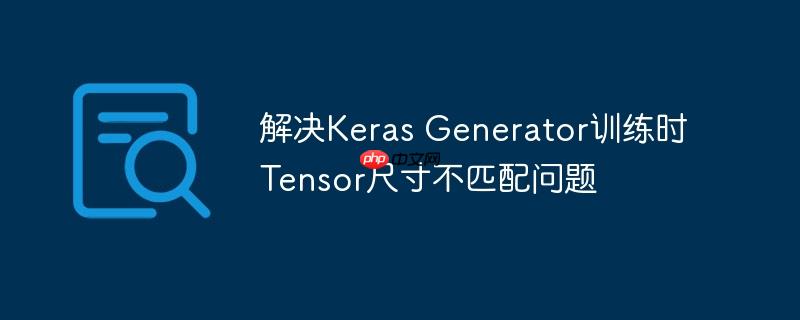
本文档旨在解决在使用Keras Generator进行流式训练时,出现的Tensor尺寸不匹配错误。该错误通常与模型结构中涉及的下采样和上采样操作有关,特别是当输入图像尺寸不是16的倍数时,可能导致维度不一致。通过调整输入图像尺寸或修改模型结构,可以有效避免此问题。
在使用Keras Generator进行训练时,如果模型包含下采样(例如,通过卷积层的stride实现)和上采样(例如,通过转置卷积层实现)操作,且输入图像的尺寸不是特定数值(通常是16或32)的倍数,则在模型的不同层之间进行连接或拼接时,可能会出现Tensor尺寸不匹配的错误。
例如,考虑一个U-Net结构,它包含下采样路径和上采样路径。在下采样路径中,图像尺寸逐渐减小;在上采样路径中,图像尺寸逐渐增大。在某些层,上采样路径的输出需要与下采样路径的输出进行拼接。如果由于图像尺寸不是16的倍数,导致下采样和上采样过程中出现舍入误差,那么拼接操作可能会失败,因为两个Tensor的尺寸不一致。
解决Tensor尺寸不匹配问题的方法主要有两种:
调整输入图像尺寸: 这是最直接的解决方案。将输入图像的尺寸调整为16(或模型中使用的其他下采样因子的倍数)。例如,如果原始图像尺寸是100x100,可以将其裁剪或缩放到96x96或112x112。
import tensorflow as tf
import numpy as np
# 假设原始图像尺寸是 (batch_size, 100, 100, channels)
def resize_image(image, target_size=(96, 96)):
"""将图像调整到目标尺寸"""
resized_image = tf.image.resize(image, target_size)
return resized_image.numpy() # Convert to numpy array
class DataGenerator(tf.keras.utils.Sequence):
'Generates data for Keras'
def __init__(self,
channel,
pairs,
prediction_size=96, # 修改prediction_size
input_normalizing_function_name='standardize',
label="",
batch_size=1):
'Initialization'
self.channel = channel
self.prediction_size = prediction_size
self.batch_size = batch_size
self.pairs = pairs
self.id_list = list(self.pairs.keys())
self.input_normalizing_function_name = input_normalizing_function_name
self.label = label
self.on_epoch_end()
def __len__(self):
'Denotes the number of batches per epoch'
return int(np.floor(len(self.id_list) / self.batch_size))
def __getitem__(self, index):
'Generate one batch of data'
# Generate indexes of the batch
indexes = self.indexes[index*self.batch_size:(index+1)*self.batch_size]
print("{} Indexes is {}".format(self.label, indexes))
# Find list of IDs
subset_pair_id_list = [self.id_list[k] for k in indexes]
print("\t{} subset_pair_id_list is {}".format(self.label, subset_pair_id_list))
# Generate data
normalized_input_frames, normalized_gt_frames = self.__data_generation(subset_pair_id_list)
print("in __getitem, returning data batch")
return normalized_input_frames, normalized_gt_frames
def on_epoch_end(self):
'Updates indexes after each epoch'
self.indexes = list(range(len(self.id_list)))
def __data_generation(self, subset_pair_id_list):
'subdivides each image into an array of multiple images'
# Initialization
normalized_input_frames, normalized_gt_frames = get_normalized_input_and_gt_dataframes(
channel = self.channel,
pairs_for_training = self.pairs,
pair_ids=subset_pair_id_list,
input_normalizing_function_name = self.input_normalizing_function_name,
prediction_size=self.prediction_size
)
# Resize the image before returning
normalized_input_frames = resize_image(normalized_input_frames, (self.prediction_size, self.prediction_size))
normalized_gt_frames = resize_image(normalized_gt_frames, (self.prediction_size, self.prediction_size))
print("\t\t\t~~~In data generation: input shape: {}, gt shape: {}".format(normalized_input_frames.shape, normalized_gt_frames.shape))
return normalized_input_frames, normalized_gt_frames
修改模型结构: 如果无法调整输入图像尺寸,可以考虑修改模型结构,例如:
Tensor尺寸不匹配是使用Keras Generator进行训练时常见的错误。通过调整输入图像尺寸或修改模型结构,可以有效解决此问题。在解决问题时,需要仔细分析模型的结构和每一层的输出尺寸,并根据具体情况选择合适的解决方案。
以上就是解决Keras Generator训练时Tensor尺寸不匹配问题的详细内容,更多请关注php中文网其它相关文章!

每个人都需要一台速度更快、更稳定的 PC。随着时间的推移,垃圾文件、旧注册表数据和不必要的后台进程会占用资源并降低性能。幸运的是,许多工具可以让 Windows 保持平稳运行。

Copyright 2014-2025 https://www.php.cn/ All Rights Reserved | php.cn | 湘ICP备2023035733号